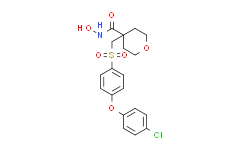| 中文名称: | CTS-1027 | ||||
|---|---|---|---|---|---|
| 英文名称: | CTS-1027 | ||||
| 别名: | 4-(((4-(4-氯苯氧基)苯基)磺酰基)甲基)-N-羟基四氢-2H-吡喃-4-甲酰胺 Ro 1130830; RS 130830 | ||||
| CAS No: | 193022-04-7 | 分子式: | C19H20ClNO6S | 分子量: | 425.88 |
| CAS No: | 193022-04-7 | ||||
| 分子式: | C19H20ClNO6S | ||||
| 分子量: | 425.88 | ||||
基本信息
|
产品编号: |
C30008 |
||||
|
产品名称: |
CTS-1027 |
||||
|
CAS: |
193022-04-7 |
储存条件 |
粉末 |
-20℃ |
四年 |
|
|
|
||||
|
分子式: |
溶于液体 |
-80℃ |
六个月 |
||
|
分子量 |
425.88 |
-20℃ |
一个月 |
||
|
化学名: |
2H-Pyran-4-carboxamide,4-(((4-(4-chlorophenoxy)phenyl)sulfonyl)methyl)tetrahydro-N-hydroxy- |
||||
|
Solubility (25°C): |
|||||
|
体外:
|
DMSO |
≥100mg/mL(234.81mM) |
|||
|
Ethanol |
|
||||
|
Water |
|
||||
|
体内(现配现用): |
1.请依序添加每种溶剂:10% DMSO→40% PEG300→5% Tween-80→45% saline Solubility:≥2.5mg/mL(5.87mM);Clear solution |
||||
|
此⽅案可获得≥2.5mg/mL(5.87mM,饱和度未知)的澄清溶液。以1mL⼯作液为例,取100μL25.0mg/mL的澄清DMSO储备液加到400μLPEG300中,混合均匀;向上述体系中加⼊50μLTween-80,混合均匀;然后继续加⼊450μL⽣理盐⽔定容⾄1mL。 |
|||||
|
2.请依序添加每种溶剂:10% DMSO→90% (20% SBE-β-CD in saline) Solubility:≥2.5mg/mL(5.87mM);Clear solution |
|||||
|
此⽅案可获得≥2.5mg/mL(5.87mM,饱和度未知)的澄清溶液。以1mL⼯作液为例,取100μL25.0mg/mL的澄清DMSO储备液加到900μL20%的SBE-β-CD⽣理盐⽔⽔溶液中,混合均匀。 |
|||||
|
3.请依序添加每种溶剂:10% DMSO→90% corn oil Solubility:≥2.5mg/mL(5.87mM);Clear solution |
|||||
|
此⽅案可获得≥2.5mg/mL(5.87mM,饱和度未知)的澄清溶液,此⽅案不适⽤于实验周期在半个⽉以上的实验。以1mL⼯作液为例,取100μL25.0mg/mL的澄清DMSO储备液加到900μL⽟⽶油中,混合均匀。 |
|||||
|
<1mg/ml表示微溶或不溶。 |
|||||
|
普西唐提供的所有化合物浓度为内部测试所得,实际溶液度可能与公布值有所偏差,属于正常的批间细微差异现象。 |
|||||
|
请根据产品在不同溶剂中的溶解度选择合适的溶剂配制储备液;⼀旦配成溶液,请分装保存,避免反复冻融造成的产品失效。 |
|||||
制备储备液
|
浓度
溶液体积 质量 |
1mg |
5mg |
10mg |
|
1mM |
2.3481mL |
11.7404mL |
23.4808mL |
|
5mM |
0.4696mL |
2.3481mL |
4.6962mL |
|
10mM |
0.2348mL |
1.1740mL |
2.3481mL |
生物活性
|
产品描述 |
一种有效的MMP抑制剂,能够作用于MMP2和MMP13。 |
|
靶点 |
IC50:0.2nM(MMP2),0.5nM(MMP13),0.7nM(MMP12),0.9nM(MMP8),9.5nM(MMP3),15nM(MMP14) |
|
体内研究 |
CTS-1027 significantly reduces the hepatocyte apoptosis, features of cholestatic liver injury, amd markers of hepatic fibrogenesis in the BDL mouse. CTS-1027 improves overall animal survival following 14 days of BDL in mice. In male animals treated for 8 weeks the terminal plasma concentration of RS-130830 is 311±45nM. Treatment of male mice with RS130830 for 8 weeks causes an 89% increase in plasma triglyceride concentration, but there is no corresponding effect in female mice treated for 12 weeks. The plaque lipid content of animals receiving RS-130830 is increased by 81% at 12 weeks, and increased by 41% at 16 weeks |
推荐实验方法(仅供参考)
|
Animal Administration |
For experimental procedures, mice are anesthetized with ketamine 60mg/kg plus xylazine 10mg/kg body weight by intraperitoneal injection. After a midline upper-abdominal incision, the peritoneal cavity is opened, the abdominal wall retracted, and the common hepatic bile duct is double-ligated below the bifurcation and transected between the ligatures as previously described by us in detail. Sham-operated mice, used as controls, also underwent similar laparotomy with exposure but without ligation of the common bile duct. The fascia and skin of the midline abdominal incision are closed with sterile surgical 5-0 sutures. Either CTS-1027 or the vector carboxymethylcellulose are administered by gavage in a dose of 10mg/kg body weight once a day. Drugs are prepared freshly on the day of the study. After 14 days of BDL and gavage, mice are re-anesthetized, sacrificed and blood is obtained from the inferior vena cava for serum total bilirubin and ALT determinations and the liver is removed, cut into small pieces and either snap-frozen in liquid nitrogen for storage at −80°C or fixed in freshly prepared 4% paraformaldehyde in phosphate-buffered saline (PBS) for 48 hours at 4°C for additional studies. Liver tissue is also subjected to RNA extraction using the Trizol reagent. Serum bilirubin and ALT determinations are performed as previously described. |
本计算器可帮助您计算出特定溶液中溶质的质量、溶液浓度和体积之间的关系,公式为:
质量 (g) = 浓度 (mol/L) x 体积 (L) x 分子量 (g/mol)
摩尔浓度计算公式
用本工具协助配置特定浓度的溶液,使用的计算公式为:
开始浓度 x 开始体积 = 最终浓度 x 最终体积
稀释公式
稀释公式一般简略地表示为:C1V1 = C2V2 ( 输入 输出 )








